On this page you will find:
- Sustainable Communities Overview
- National Landscapes Parishes
- Roads and Transport
- Rural Business
- Waste
- Use and Disposal of Water
- Key Facts and Figures
- Sustaining the Landscape
- Management Influences and Forces for Change
- Policies and Priorities for Sustainable Communities
Sustainable Communities Overview
Sustainable communities are places where people want to live and work, now and in the future. They meet the diverse needs of existing and future residents, are sensitive to their environment, and contribute to a high quality of life. They are safe and inclusive, well planned, built and run, and offer equality of opportunity and good services for all.
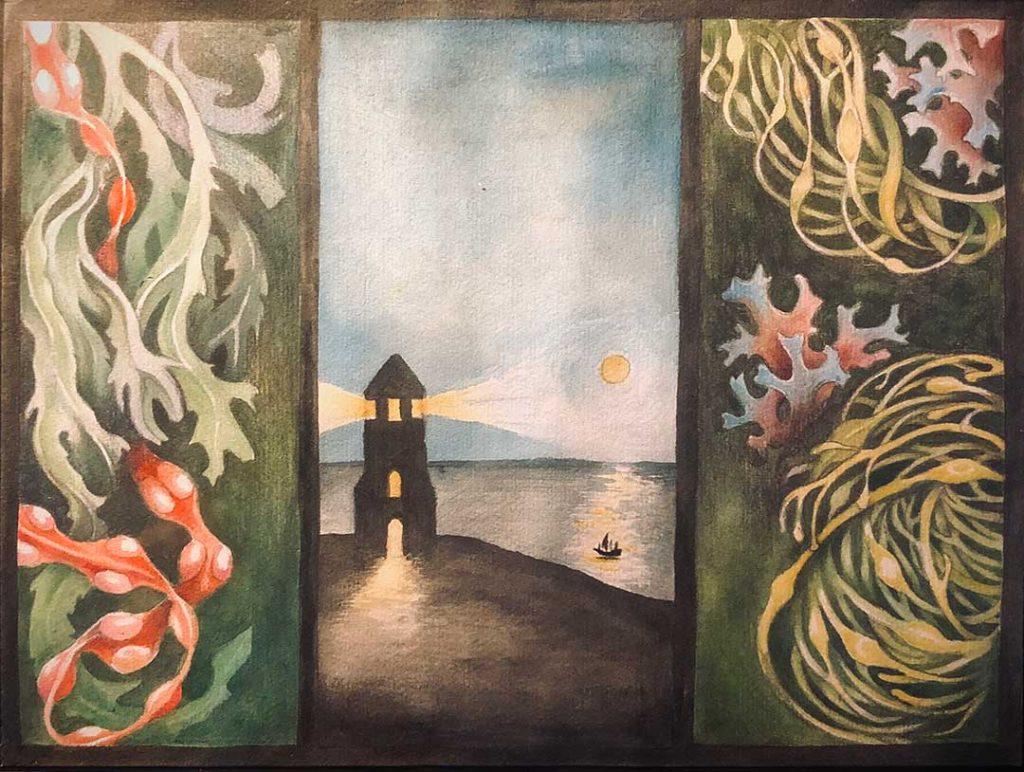
The landscape of the Isle of Wight AONB has been shaped over the centuries by the activities of people. Its character adds to the quality of life of communities within the designated landscape and is the draw for the millions of visitors who come to the Isle of Wight each year.
The Isle of Wight National Landscape team led the nomination for the designation of the whole island and its surrounding waters to become a UNESCO World Biosphere Reserve (‘Biosphere’) between 2017 and 2018. The designation was awarded by UNESCO in 2019106. This designation celebrates the sustainable approach adopted by Isle of Wight community and is reflected in local policy and its implementation.
Landscape Character Assessments29,33,34 and Historic Landscape Characterisation32 help us to better understand and describe the special qualities and time depth of the individual areas that make up the wider AONB.
National Landscapes Parishes
Approximately 8400 (6% of the Island population) people live in the Isle of Wight National Landscape107.
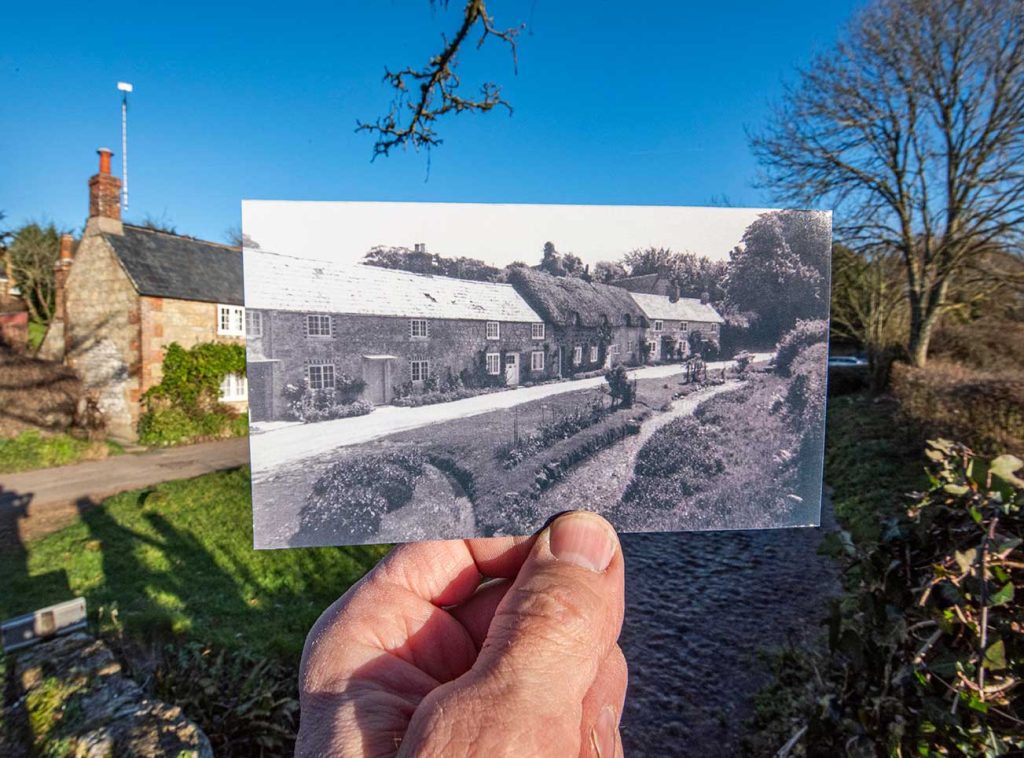
Traditional settlement patterns, vernacular design and the lack of a single predominant building style reflect the diverse geology and landform of the Isle of Wight National Landscape. This adds to the interest and distinctiveness of the towns and villages within and adjacent to the area. Living and working in their immediate area; historically, communities would have been more self-sufficient, reliant on what the landscape in their area could provide. Today’s National Landscape includes communities from isolated farmsteads and hamlets to villages of varying sizes and one small town (Yarmouth). Taking into account the fragmented nature of the Isle of Wight National Landscape, the designation can be found in all but four of the Island’s parishes.
Life in today’s National Landscape includes the following issues and opportunities:
- Globalisation – the availability of modern (often generic) commodities and communications.
- Demographics – changing age profiles.
- Services – economic viability of maintaining needed and effective rural services.
- Connection – sense of belonging, social interaction, social exclusion.
- Employment – commuting outside of the area, self-employment, home working.
- Housing – affordability, second-homes, holiday lets, age and condition of stock and supply.
- Localism – empowering local communities to decide on matters concerning their future.
Roads and Transport
The Isle of Wight AONB’s road network provides access to the diverse landscapes across the area. It provides the means for transporting goods and for accessing many services for people who live in, work in or visit the area.
Highway maintenance has in recent times focused on motor traffic on all roads, reflecting the bulk of their use; however, this should not be at the expense of road users on foot, in wheelchairs, on bicycles or horseback. Alongside motor vehicles, the needs of other road users must be considered in order to encourage an increase in sustainable transport options, healthier lifestyles, better social inclusion and access to the countryside.
The minor and unclassified road network contributes to the character of the Isle of Wight National Landscape and can contribute to sustainable transport approaches. Verges, hedges and historic signs all add to the local distinctiveness of the landscape. The standardisation of signage and the design of road schemes have a major impact on the local distinctiveness and the character of an area. Traffic regulation requires signage and there are fewer discretionary powers regarding its design, size and placement. The design of new road schemes, signage and road furniture needs to be sympathetic to the landscape. Maintaining existing signage and programmes to rationalise signs, can help to ensure that the impact is minimised. The use of temporary plastic signs, and of street furniture for fly posting, should be discouraged.
Maintaining strategic roads within the National Landscape is an on-going challenge, especially in areas subject to coastal erosion and/or active land movement. This will need to balance carefully the social and economic need for the road network with its potential impact on the environment. Although distances between settlements on the Isle of Wight are lower than in other rural areas of England, a high proportion of rural dwellers do not have access to a car during the working day. They therefore rely on public transport. This needs to be regular, reliable, affordable and convenient if it is to provide an alternative to the car.
Rural Business
It will be very important for the economic health of our rural economy to ensure the continuation of a wide range of economic activity. As Island businesses become increasingly national and global in their outlook, there will be an increasing tendency for these businesses to locate near our ferry gateways to improve accessibility to cross-Solent travel and beyond – both for themselves and their customers. If these businesses are going to be our higher value businesses, then the National Landscape needs to find ways of avoiding having only the low-value sectors in its area.
Consequently, there is a need to improve the wealth and job-creation potential of the IWAONB, by improving the productivity of the larger sectors and promoting the growth of higher productivity sectors. For example, developing higher value-added tourism should see an improvement in the productivity of the hotels and catering sector. By encouraging and enabling the Agriculture/ Forestry/ Fishing sector to explore ways of adding value to their products, this will encourage new jobs and wealth creation in these areas.
Investment in broadband connectivity to isolated rural communities is an important factor in increasing sustainable businesses in the designated landscape.
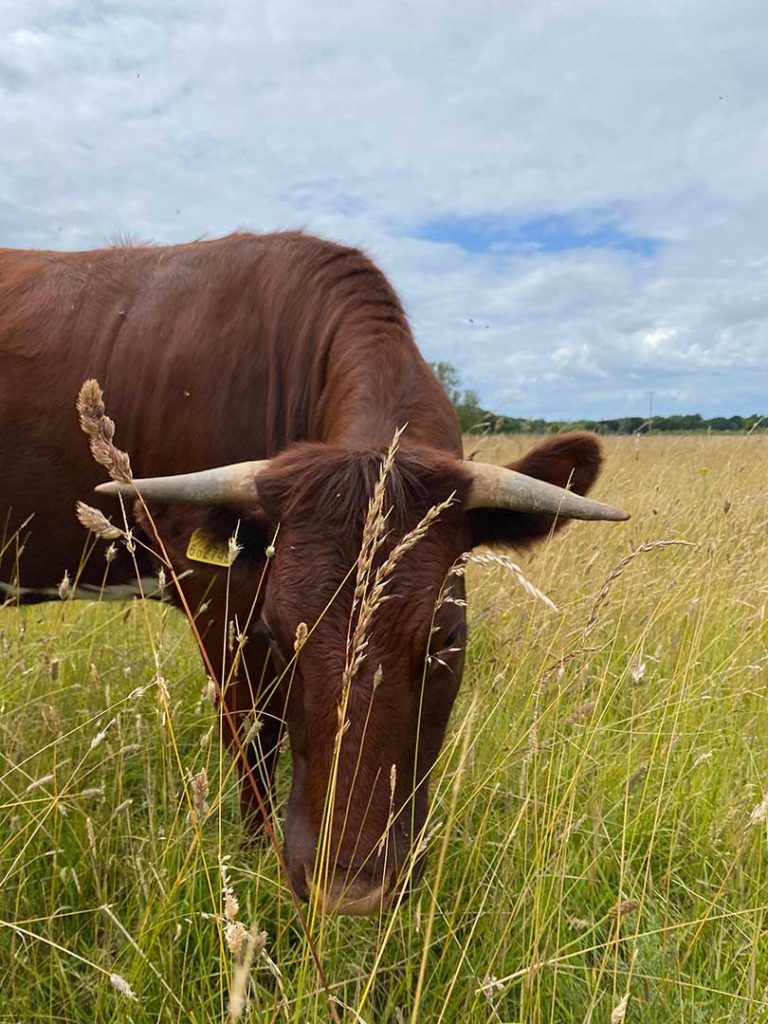
Waste
Waste – the level of consumption and use of resources on the Isle of Wight is related to:
- Island status (transporting goods on and off the Island).
- Natural resource availability/management.
- Lifestyle.
All of these factors have an impact on the landscape. A particular pressure is the disposal of waste to land fill as the Island’s land fill site is located within Isle of Wight AONB, as well as the waste sorting facility and a number of other isolated waste management sites.
The Isle of Wight Council aims to re-use 61.79% of household waste; recycle / compost 55% municipal waste; recycle / compost/ re-use 75% of waste from household recycling centres and divert 90% of all contract waste from landfill108.
Recycling rates have increased as methods have been introduced to make domestic recycling more convenient. Economies of scale for commercial and domestic waste decrease the economic viability for recycling. There is a need to work with waste operators to ensure the short term impact on the landscape is minimised and in the longer term the landscape is restored appropriately. A good example of this is at Standen Heath where parts of former landfill have been re-landscaped.
Use and Disposal of Water
The availability and use of water is an important element in the sustainable development of the Isle of Wight AONB. Factors include levels of personal water consumption and the associated water efficiency standards in housing. This is in the light of 25% of the Island’s water coming from the mainland, which, in drought conditions, could lead to increased pressure on flows in these important chalk stream habitats.
Furthermore, the removal and treatment of waste water can cause negative environmental impacts, particularly in the light of the regular overwhelming of foul water sewers with rainwater in recent high rainfall events. These events will only become more common with climate change leading to increased flooding of sewers affecting rivers and in-shore waters. Water companies and owners of septic tanks should be encouraged to seek solutions to this problems.
These issues are addressed on the Air and Water page – Air and Water – Isle of Wight National Landscape
Key Facts and Figures
Population – The most recent census109 shows the total Isle of Wight population as 140,500, of this population approximately 6% (8,401) reside within the IWAONB. However, it is important to reiterate the interrelationship between the IWAONB and the rest of the Isle of Wight. Many of the more built-up and urban areas are close to the designated landscape making it readily accessible. People will travel in and out of the area to access work, leisure opportunities, essential services for their health and wellbeing and to shop.
Of the 33 parishes on the Isle of Wight, twenty-nine have the designation within their boundary – Cowes, Nettlestone and Seaview, Northwood and St Helens are the exceptions. Of the rest, only three are entirely within the designated area – Shorwell, Brighstone and Chale.
The Isle of Wight National Landscape team includes a Planning officer who responds to planning applications submitted to the local planning authority for permission within the designated landscape. Approximately 25% of all planning applications submitted to the local authority are within the AONB. The Planning Officer’s responses are published on the Isle of Wight Council’s Planning part of their website. The record of the effectiveness of the Planning Officer’s responses are shown on the graph below:
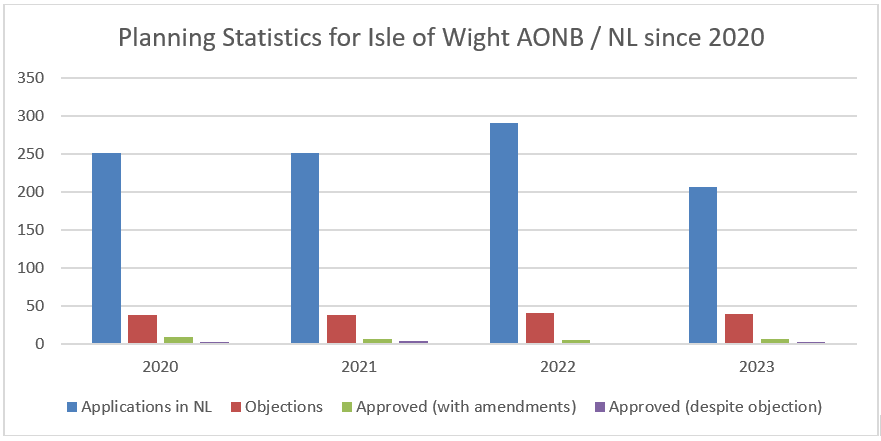
Over the past four years, of the 897 planning applications submitted to the local authority that are within the AONB, nine (<1%) have been approved despite our objections.
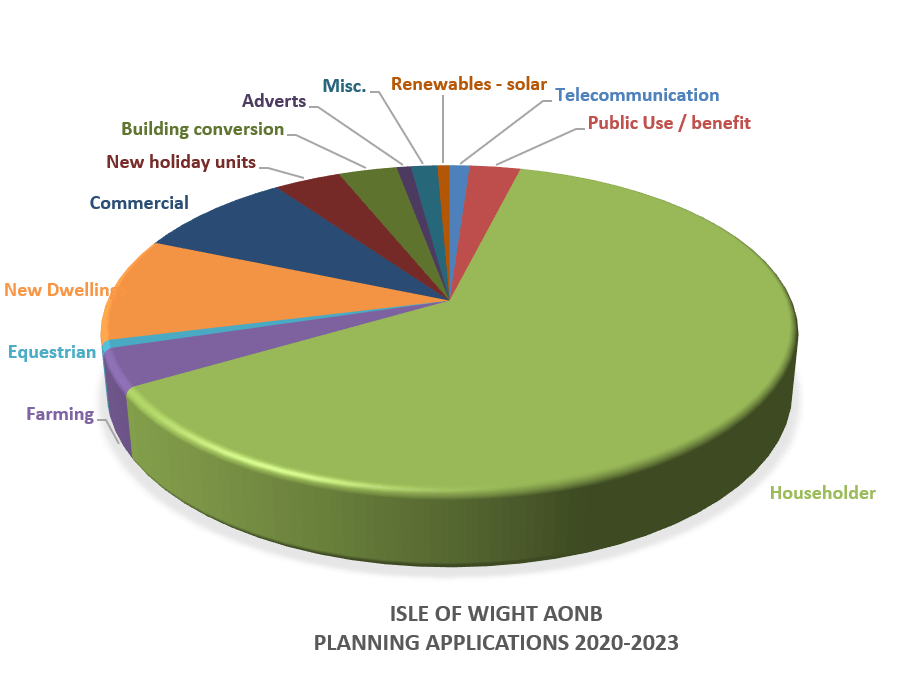
Over the past four years householder applications (general, extensions, outbuildings and fencing / drives) have dominated planning work (63% of all applications submitted).
Sustaining the Landscape
National Landscape Parishes
Sympathetic development within the designation, reflecting appropriate vernacular style and materials, will ensure the conservation and enhancement of the landscape’s unique sense of place. There is a need to take into account the high sensitivity of the landscape when considering development, yet also maintain healthy and vibrant local communities and enable access to goods and services.
Landscape Character Assessments and Historic Landscape Characterisation provide detailed information on the character of the individual parishes.
Roads and Transport
The highways network provides access to the diverse landscapes across the National Landscape. It provides the means for transporting goods and access to many services for people who live and work in, or visit the area. Care is required to ensure that generic approaches are avoided wherever possible to minimise their impact on local distinctiveness and the character of the designation.
Rural Business
Economic development needs to link with maintaining the strength of communities. It may well be that rural productivity is lower because much of the service provision is not as profitable in small towns and villages as it would be in urban areas. However, these service businesses provide economic and social “glue” for local communities, and their successful survival needs to be promoted, encouraged and assisted.
Waste
The Island cannot move waste between authorities for treatment (such as bulking prior to processing or recycling) or share the investment costs of waste infrastructure. This increases the pressure for land fill and its impact upon the designated landscape. Smaller scale solutions are being sought on the Island which will help to reduce this pressure for additional land fill but it unlikely to address the issue fully.
Management Influences and Forces for Change
National Landscape Parishes
Development Pressures – As identified on section 3.8.2 and section 3.9.3 of this document, the National Planning Policy Framework and the Island Plan set out the Policy context for development and as such has a direct bearing on the sustainability of communities within the Isle of Wight AONB. The adopted Island Plan is undergoing a review (called the Island Planning Strategy)
The Island Plan Core Strategy (2012)71 clearly describes a hierarchy for the spatial location of development.
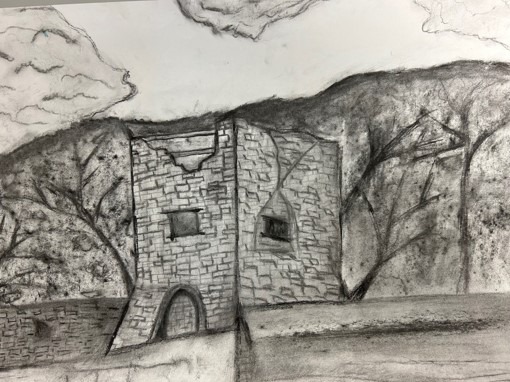
Development here has the most restrictions, and also requirement to prove need in that location. The Island Plan does allow for appropriate tourism related development where it is contributing to sustainable (green) tourism, generally raising the quality of the tourism offer or providing a for a particular niche market. In the Isle of Wight AONB, we would expect the planning application process for such proposals to fully consider the likely impact on the conservation and enhancement objectives of the designation and the other policies within this Management Plan.
There is a presumption against major development within the National Landscape. Major development in the designated landscape is a matter for the decision-maker taking into account its nature, scale and setting and whether it could have adverse impacts on features for which the area was designated.
The Wider Rural Area covers the remaining countryside areas and small villages of the Island and includes much of the Isle of Wight AONB.
Where there is no alternative to the development, a thorough assessment of its potential environmental and visual impact is required. This often triggers the need for a formal Environmental Impact Assessment.
Five parishes have adopted Neighbourhood Plans110 all of which have the Isle of Wight AONB in their boundary – Brading, Brighstone, Bembridge, Gurnard and Freshwater. An application for Yarmouth and Thorley to become a create a Neighbourhood Plan is currently being considered (2023). Although most mention the AONB, only two refer to the Isle of Wight AONB Management Plan.
Small-scale development is less well regulated and certain activities (both small and large) are allowed under permitted development rights. Although this is more stringent in the designated landscape, the cumulative impact of such small-scale change can be damaging to the character of an area and its overall ‘sense of place’. The agricultural sector, for example, benefits from permitted rights for some development.
It is important that any development proposals within the designated landscape are based upon a proper formal assessment of need through documents such as Housing Need Surveys and adopted Neighbourhood Plans. All proposals would still be expected to be of high quality design and be in keeping with the landscape character of the local area.
For the continued conservation and enhancement of the landscape, there is a need for land management practices to be maintained. There may be occasions where there is a need for agricultural, woodland and rural workers to live where they work, or additional buildings in relation to the land management sector. There is a need for the Isle of Wight National Landscape to better understand the future requirements for a sustainable rural economy and how this can be facilitated without having a negative impact on the designated area.
Certain authorities and public bodies also have specific permitted development rights for public services such as highways and the utility companies. Such activities are covered by the duty to further the purposes of the AONB outlined in the Countryside and Rights of Way Act 2000 (as amended)5, in addition to existing duties under the National Parks and Access to Countryside Act 19493.
Roads and Transport
The Isle of Wight Local Transport Plan 2011-2038111 gives the policy context for the highways network. This sets out aspirations and targets for improved sustainable transport networks throughout the Isle of Wight AONB. Key aspirations within this plan include:
- Helping to ensure that people can get into and around the AONB.
- Minimise the environmental impact of travel and transport.
- Making the best use of sustainable transport routes.
- Promoting sustainable transport to locals and visitors alike.
- Improving quality of life.
As the local Highways Authority, The Isle of Wight Council manages a Private Finance Initiative (PFI) for highways. The PFI contractor, Island Roads, is required to deliver the necessary improvements and maintenance (fence to fence) of the complete road and cycleway network. This includes works to all the Isle of Wight AONB roads over the life of this Plan. The document ‘Considering the Island’s landscape, natural and historic environment – Guidance for Work on the Highways and Public Realm’112 was produced to inform these works.
Challenges for the maintenance of the road network include the A3054 between Bouldnor and Yarmouth and the A3055 between Brook and Freshwater Bay which suffers from periodic landslip and ground instability. The section of the A3055 between Niton and St Lawrence was closed in 2014 due to major landslips and an inability to restore vehicular access.
A HEAP Report56 on Historic Routeways (including Hollow Ways, also known as sunken lanes)discusses the origins and character of roads and public rights of way, making proposals for future management and study.
Rural Business
A number of funding mechanisms may be able to help with the development of small rural business in the Isle of Wight AONB, particularly where it relates to adding value to farming, forestry or is for green tourism.
Local Neighbourhood Plans provide the opportunity for local communities to influence development within their local area based on the views of the residents, businesses and other stakeholders in the area. Bembridge, Brading, Brighstone, Gurnard, Freshwater currently have these plans in place.
The WightFibre ‘Gigabit Island Project’111 aims to provide full-fibre broadband to over 60,000 homes and businesses across the Island by 2024 and is already available to over 57,000 households. The project has received over £110M from Infracapital Partners (including funding from HM Treasury) and NatWest Bank. WightFibre is also receiving funding from Broadband Delivery UK (BDUK) to extend the reach of our network to some 80,000 premises on the Island.
Farm diversification may include small rural business units, read more on the Farming page – Farming – Isle of Wight National Landscape.
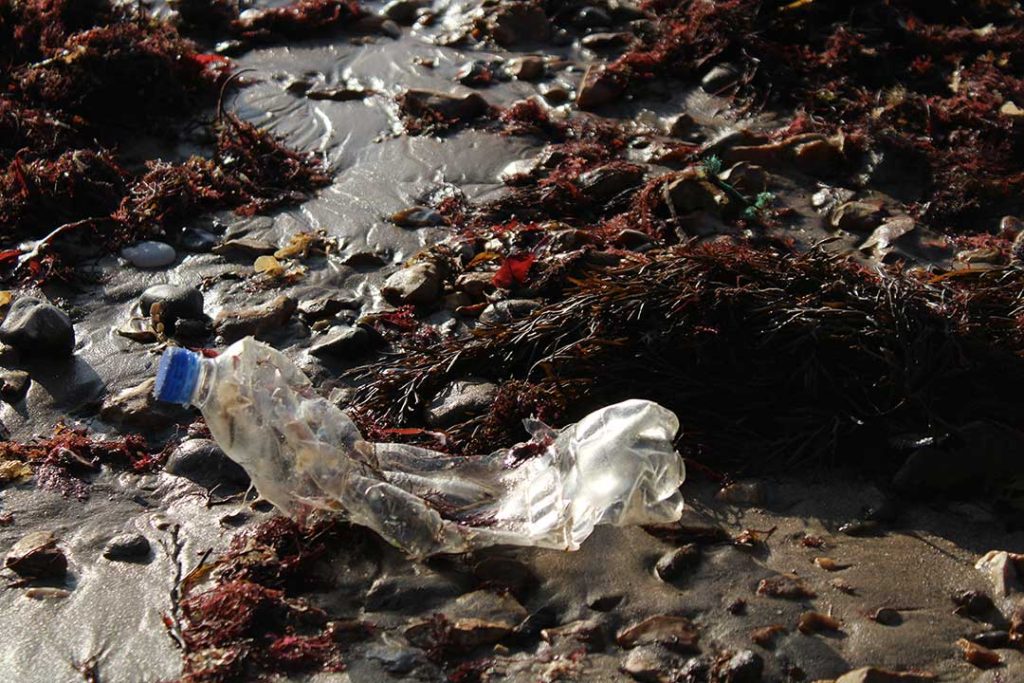
Waste
The Isle of Wight Council awarded the waste management contract to Amey Cespa in 2015 for 25 years. A target of 90% of household waste to be diverted from landfill was expressed and waste treatment works at Parkhurst Forest are being deployed.
A waste processing works has also been established by Westridge Waste in the Isle of Wight AONB at Combley, opposite the Standen Heath site. The company supplies skips and containers and includes commercial tipping facilities. Waste that cannot be recycled is tipped at the Lynn Pitt Transfer station on site.
The level of public support and uptake of recycling will have an impact on the levels of landfill as will the treatment of commercial waste.
Policies for Sustainable Communities
These policies should be read in conjunction with the overarching objectives for the Isle of Wight AONB as detailed on the welcome and overview page – Isle of Wight National Landscape: Area of Outstanding Natural Beauty Management Plan 2025-2030 – Isle of Wight National Landscape.
National Landscape Parishes Policies
P38 Ensure that the IWAONB objectives are given full regard in the formulation, review and implementation of plans and policies affecting parishes, for strategic planning documents, local initiatives, etc.
P39 Support IWAONB parishes and community groups to deliver local initiatives, which involve people in the appreciation of active conservation and enhancement of the designated landscape at a local level.
P40 Ensure that development proposals for sustainable rural communities (services, housing etc) complement the character of the area, strengthening its local distinctiveness and has provided robust evidence of need in that location.
P41 Encourage sensitive approaches and increase communication with owners of permitted development rights within the designated landscape.
Roads and Transport Policies
P42 Ensure that IWAONB objectives are given full regard in the approaches taken to road management and maintenance.
P43 Encourage sensitive approaches and seek opportunities to strengthen the contribution of the road network (including footways, street lighting, grass verges, drainage and street furniture) to the character and the local distinctiveness of the Isle of Wight AONB.
P44 Encourage and promote sustainable access to the Isle of Wight AONB through the use of public transport, walking and cycling to establish a sustainable transport network integrating roads and public rights of way.
P45 Promote approaches that encourage better sustainable transport integration between the road network and public rights of way.
Rural Business Policies
P46 Support sustainable rural enterprise (and associated infrastructure development such as broadband) where it respects the purposes of the designated landscape
P47 Encourage better rural broadband connections to more isolated communities and businesses.
P48 Support initiatives that add value to land-based products and make them more sustainable.
Waste Policies
P49 Encourage ways to reduce waste through encouraging more careful consumption, recycling and lower land fill rates.
P50 Ensure proposals for landfill and waste management fully consider the impacts on the landscape of the Isle of Wight AONB and take full regard of the purpose of the designations, in both active and restoration phases.
Priorities for Delivery
- Support local communities in their understanding of IWAONB objectives and their role in the delivery of these.
- Support strategic bodies and local organisations to ensure that green infrastructure opportunities are maximised throughout the designated landscape.
- Support approaches and initiatives that encourage local sustainable transport.
- Encourage and support the local highway authority and Island Roads to review their management and maintenance programme in light of the purposes of the designated landscape
- Encourage industry, regulating bodies and landowners to ensure IWAONB objectives are embedded in waste management and land fill proposals.